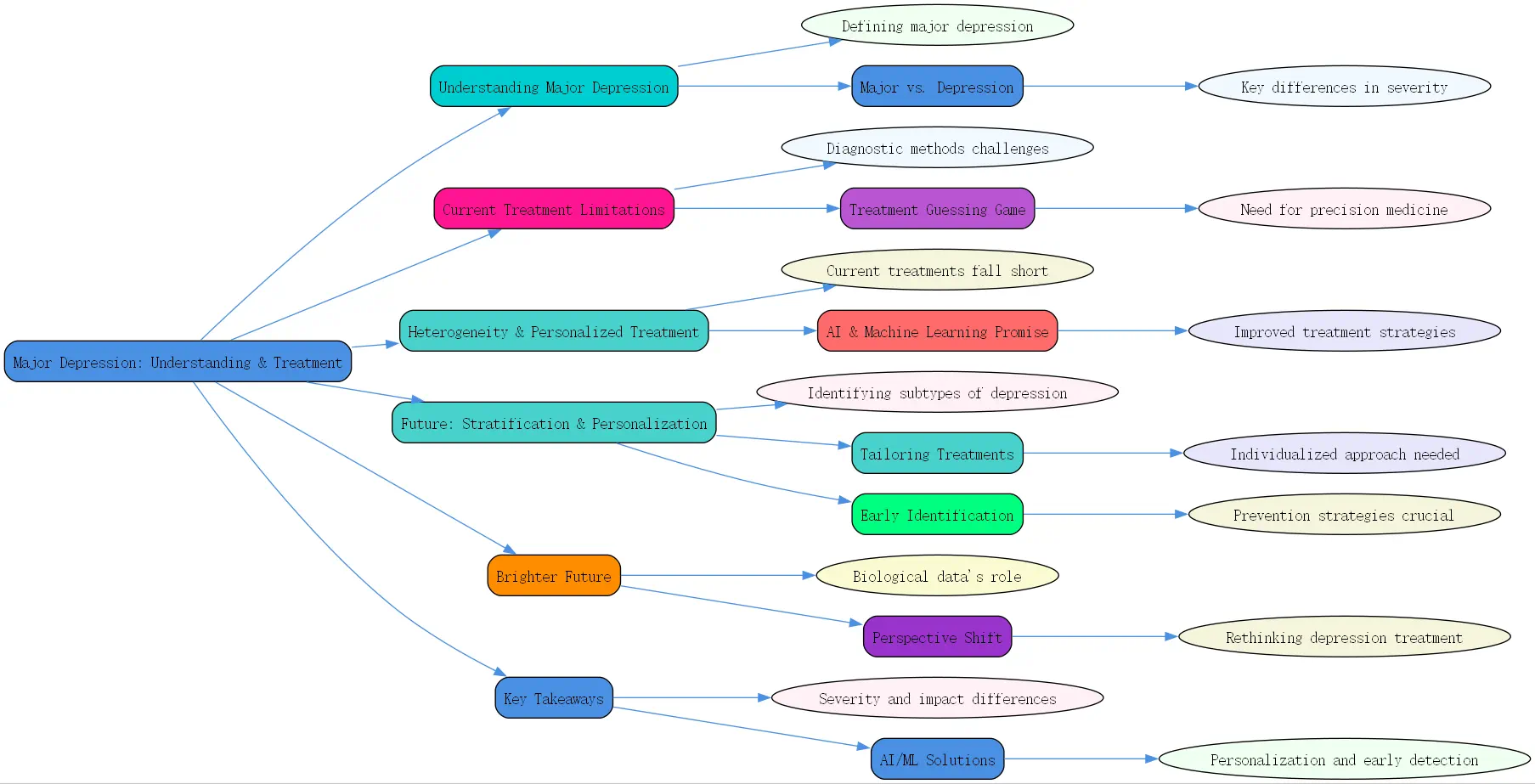Understanding Major Depression

What is Major Depression?
Major depressive disorder (MDD), commonly referred to as major depression, is a severe mental health condition characterized by persistent feelings of sadness, loss of interest in daily activities, and physical symptoms, such as fatigue, changes in sleep, and appetite issues. To receive a diagnosis, these symptoms must last for at least two weeks and significantly interfere with daily life.
The story of Jay illustrates the devastating impact of this illness. On the surface, Jay had what many would consider a perfect life—an excellent career, supportive family, and loyal friends. However, Jay quietly struggled with major depressive disorder, an officially recognized diagnosis from leading medical professionals. Despite undergoing treatments, spending weeks in a mental health facility, and being closely monitored, her outcome was heartbreakingly tragic.
Unfortunately, Jay’s story is far from unique. According to the World Health Organization, over 700,000 people died by suicide worldwide last year, and for every suicide, approximately 20 others attempted it. In the U.S., one in five adults is diagnosed with major depression, and it ranks as the leading cause of suicide attempts, especially in adults under 35—a sobering reminder of the gaps in our mental health systems.
Major Depression vs. Depression: Key Differences
The terms “”depression”” and “”major depression”” are often used interchangeably, but they describe different experiences. Understanding their distinctions is crucial for effective treatment.
1. Severity of Symptoms: Depression can range from mild to severe, while major depression represents the more intense end of the spectrum. Major depressive episodes disrupt daily functioning, making it difficult or impossible to work, maintain relationships, or even manage self-care.
2. Duration of Symptoms: Everyday sadness or temporary feelings of low mood usually improve within days or weeks. In contrast, major depression persists for at least two weeks and often lasts much longer if untreated.
3. Impact on Life: While some forms of depression allow individuals to function, albeit at reduced capacity, major depression fully engulfs a person’s ability to engage in meaningful daily activities. Its deep emotional toll often leads to physical exhaustion, feelings of worthlessness, and even suicidal ideation.
Recognizing these differences is vital in understanding the nuances of depression vs. major depression and ensuring that treatments are tailored accordingly.
The Current State of Mental Health Treatment
Limitations of Current Diagnostic Methods
When diagnosing physical ailments such as cardiac problems, doctors rely on objective tools: X-rays, bloodwork, and electrocardiograms. In contrast, mental health diagnoses depend almost entirely on subjective questionnaires and interviews. While these tools can be helpful, they carry risks of personal bias, miscommunication, and misdiagnosis. A diagnosis of depression often reflects symptoms, not the condition’s root cause.
The Guessing Game of Treatment
The trial-and-error nature of current treatments further complicates matters. Patients are typically prescribed antidepressants based on standard guidelines instead of their unique biological profile. It can take months—or even years—to identify a medication or therapy that works, potentially worsening symptoms during this process.
Stagnation in Psychiatry
Despite significant advancements in other medical fields, psychiatry has seen little progress over the last three decades. This stagnation has left patients and doctors without concrete tools to address the underlying complexity of mental illnesses like major depression.
The Heterogeneity of Major Depression and the Need for Personalized Treatment
Why Current Treatments Fall Short
One reason current treatments fail many patients lies in the heterogeneity of major depression. Although it shares the same name, depression manifests differently in different individuals. A treatment that works for one patient might exacerbate symptoms in another. The lack of personalized strategies forces doctors to rely on a one-size-fits-all approach, which is rarely effective.
Additionally, the trial-and-error process of matching medications to individual patients can be an emotionally draining ordeal. Patients face delays in recovery, heightened symptoms, and an increased risk of self-harm, making a strong case for more precise, personalized interventions.
The Promise of Artificial Intelligence and Machine Learning
Emerging technologies like artificial intelligence (AI) and machine learning (ML) offer transformative potential in addressing the challenges of depression and major depression. By analyzing large sets of data, these tools could help researchers decode the intricate relationships between biological markers and mental health disorders.
Advancing Our Understanding of Mental Disorders
AI can identify patterns in brain activity, genetic markers, and other biometrics. Through this analysis, researchers can differentiate between various subtypes of major depression, paving the way for more tailored solutions.
Developing Novel and Targeted Treatments
Machine learning could also dramatically improve clinical trials and medication effectiveness. With enough data, it has the potential to predict whether a patient will respond to a particular antidepressant even before treatment begins. This would eliminate much of the trial-and-error guesswork that frustrates patients and healthcare providers alike.

Stratification and Personalization: The Future of Depression Treatment
Stratification: Identifying Subtypes of Depression
Stratification is the process of categorizing patients based on their unique symptoms, biological markers, and treatment outcomes. Using AI, mental health professionals can group individuals into distinct subtypes of major depression. This clarity allows doctors to refine diagnoses and apply more targeted approaches.
Personalization: Tailoring Treatments to the Individual
Once subtypes are identified, the next step is personalization. By incorporating MRI or PET scans, EEG data, and genetic profiles, doctors can craft a treatment plan that matches each patient’s specific biological makeup. This approach minimizes risks and boosts the likelihood of lasting improvement.
Early Identification and Prevention

One of AI’s most exciting possibilities is its capacity for early detection. By recognizing subtle changes in biological markers, it may soon be possible to forecast mental health challenges before they become debilitating. Early intervention could dramatically reduce cases of suicide associated with depression and major depression.
A Brighter Future for Major Depression Treatment
The Role of Biological Data
Biological data is the foundation for achieving breakthroughs in mental health care. Technologies like MRI or EEG scans, coupled with genetic information, provide crucial insights into how depression affects the brain and body. Recent research has demonstrated the power of machine learning tools in this context. For example, studies using fMRI data have successfully identified depression subtypes and predicted treatment responses with incredible accuracy.
Depression and Major Depression: A Shift in Perspective
AI is ushering in a paradigm shift—from treating depression as a collection of symptoms to understanding it as a complex condition rooted in identifiable causes. This transformation could redefine how we perceive mental health, offering not just treatment but also prevention strategies that address underlying vulnerabilities before they escalate.
Jay’s Story Revisited: A Hopeful Future
Imagine a future where Jay’s treatment didn’t rely solely on vague questionnaires or general guidelines. Instead, her care would integrate cutting-edge AI analysis. By understanding her unique biological profile, doctors could prescribe personalized therapies tailored to her individual needs. In this future, AI and human experts work together to minimize misdiagnoses and optimize recovery, giving patients like Jay a second chance at life.
Q&A Section

Q: What makes major depression different from everyday sadness?
A: Major depression is a clinical condition with severe, long-lasting symptoms that disrupt daily life. Unlike temporary sadness, major depression requires medical intervention and persists for weeks, months, or even years, depending on the individual.
Key Takeaways:
- Major depression differs from regular depression in severity, duration, and impact on functionality.
- AI and machine learning offer promising solutions to unravel the complexity of depression through stratification, personalization, and early detection.
- Biological data advances could prevent misdiagnoses and significantly improve treatment outcomes for patients with major depression.
- In the future, personalized mental health care can save lives and offer hope where it is currently lacking.




